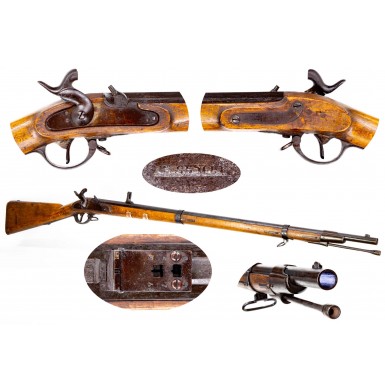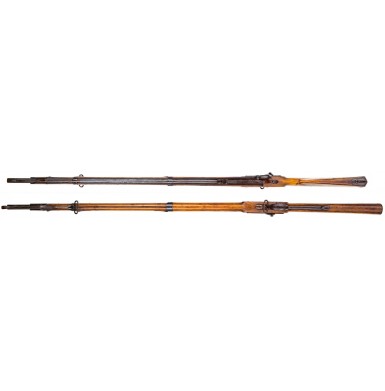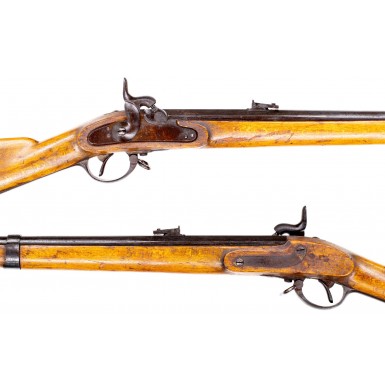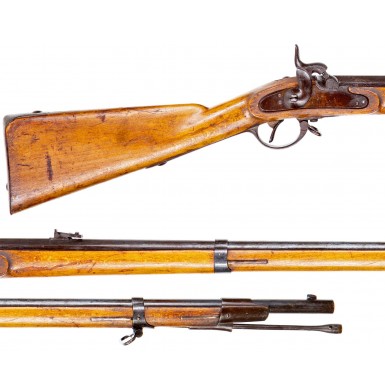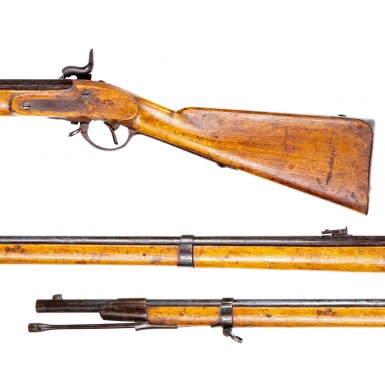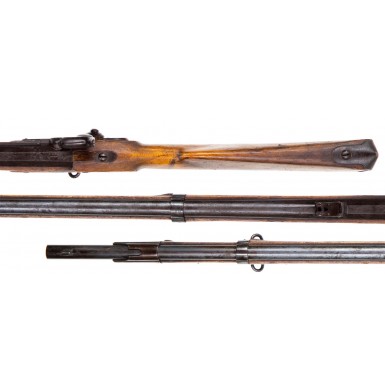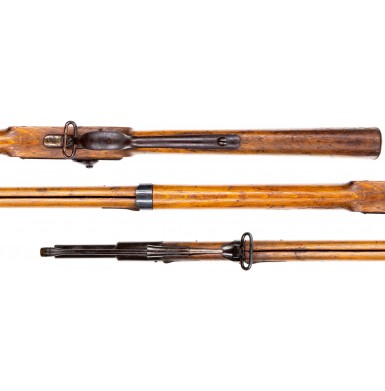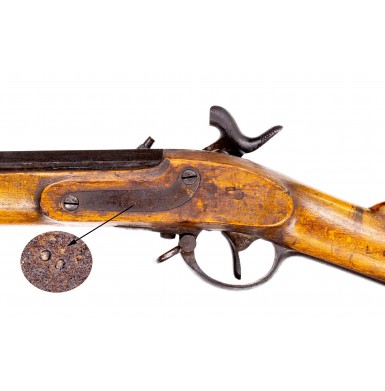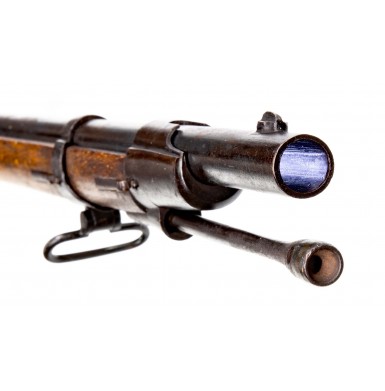Austrian Model 1854 Lorenz - Fine & Untouched Blued Commercial Variant
- Product Code: FLA-3747-SOLD
- Availability: Out Of Stock
-
$1.00
This is a really attractive example of the desirable Austrian Model 1854 Lorenz Rifle Musket, in extremely crisp and untouched condition. The Lorenz was the third most used rifle musket during the American Civil War, with US purchases in excess of 250,000 and documented CS purchases of at least 100,000. While it has long been assumed that the block sighted Lorenz rifles without cheek rests were CS imports, and the long-ranged sighted guns with cheek rests were US imports, the reality is that neither the presence or absence of a cheek rest or the style of sight is any indication of which side may have purchased the gun.
One indicator that does apply to US and CS purchases is that in general the US purchased most of their Lorenz rifles in 1861 and 1862, initially receiving the oldest guns in the Austrian military inventory. Many of these guns underwent modification or repairs in Belgium on their way to the US. Often, they were also supposed to be re-bored to the standard US .58 caliber during the refurbishment process, but this had mixed results and the guns often varied considerably form the standard. Most of the CS Lorenz purchases were made from early-1862 through the end of the war. Due to the large debts that the Confederate government accrued in England during the first part of the war, the numbers of English suppliers that were willing to extend additional credit to the Confederacy became rather limited by the end of 1863. However, Austrian suppliers were still willing to keep selling the guns, even to a client that might default on the credit extended to them. It is interesting to note researchers have recently discovered that the very first Lorenz purchases that Caleb Huse made were in early 1862 and through the firm of S. Isaac’s & Campbell Company in England. These purchases have never been included in the 100,000 CS purchases that most researchers refer to, so it is quite possible that CS purchases of the Lorenz were significantly higher than previously assumed.
The importance of the .54 caliber Austrian M1854 Lorenz to the Confederacy might best be illustrated by the huge number of Austrian Rifle Cartridges that were imported by the Confederacy from both Austria and England. The McRae Papers contain several invoices from the famous English ammunition manufacturer Eley Brothers that include Austrian ammunition. One such invoice is dated July 18, 1863, some two weeks after the Battle of Gettysburg and the fall of Vicksburg, MS. The invoice is for a total of 700,000 paper cartridges. The order included: “600,000 Austrian Rifle Cartridges – Marked A” and “100,000 Ball & Buck Short Musket Cartridges – Marked M”. While the caliber of the Austrian cartridges is not specified, it seems clear that the order would be for Austrian pattern ammunition appropriate for the unaltered .547” (13.9mm) bore of the Austrian Lorenz rifle musket. This order also implies that the Confederate Ordnance Department laboratories were capable of supplying a sufficient number of .577 / .58 caliber cartridges for the guns in the field but needed assistance in providing enough ammunition for Lorenz rifles and smoothbore muskets. This invoice also helps to dispel the myth about the issuance of .54 “Mississippi” rifle ammunition for use in the Lorenz. While this ammunition could be used in extreme circumstances, it would in fact be significantly undersized in the Lorenz bore and would not expand sufficiently to correctly take the rifling, or worse would experience the blow-out of the skirt, leaving a ring of lead in the bore that could prevent the rifle from being loaded again without a serious cleaning. I believe that many of the period reports that describe the Lorenz rifle musket as “inaccurate” are the result of using inappropriately sized ammunition intended for M1841 rifles.
One feature that almost assures that a Lorenz was purchased and imported by the North or the South is the absence of a cheek rest on the stock. All Austrian military purchased Lorenz rifle muskets were equipped with a cheek rest. Arms made for commercial or export sale often had this feature omitted, likely as a way to save time and cost. The Lorenz saw very limited use outside of Austria, so commercial arms were almost always assembled for export to the two American Civil War belligerents. Sometimes these commercial guns utilized older, obsolete Austrian military locks that were refurbished for use on the Lorenz. It is not uncommon to find locks from earlier Model 1838 and Model 1842 muskets that have been reengineered for use in a Lorenz; having been ground down to the smaller, sleeker Lorenz profile with the Augustin Consol lock parts removed and the associate holes plugged. These locks are usually identifiable by those plugged holes in the lock, and production dates that are earlier than 1854, the year that the Lorenz rifle musket first went into production. Of course, plenty of cheek rest equipped Lorenz Rifle Muskets were imported during the Civil War, however most of these were Austrian military surplus arms, rather than newly made commercial guns. While the majority of the Lorenz rifle muskets imported by both sides arrived with “arsenal bright” finishes, some of the commercial Lorenz rifle muskets (not those sold as surplus by the Austrian military) were blued. This fact lead to the guns developing the nickname among some troops as “Austrian Enfields”, referring to the deep black-blue finish typical of the English long arms.
This commercial Lorenz is complete and original in every way, including the small parts such as the rear sight, sling swivels and ramrod. The gun is in FINE original condition is very attractive and untouched with a thick layer of oxidized brown patina on much of the furniture and the lock. The lock is unmarked, a quick indication that this is not an Austrian K.K. Army surplus rifle musket.
The top of the breech is stamped with the name of Vienna arms maker T H SEDÆRL, in a single line reading from the breech towards the muzzle. The mark is somewhat unevenly struck making it not fully legible. SEDÆRL was listed in the Austrian directories as a “Waffenfabrikant und Büchsenmacher in Wien-Ottakring” (Arms Manufacturer & Gunsmith in Vienna - 16th District). SEDÆRL manufactured arms have been noted from as early as 1860 through the late 1870s, and he probably operated for a longer period than that, but my command of German is non-existent, making research on Viennese arms makers rather difficult. Thank goodness for “Google Translate”. The breech is not stamped with the Austrian military acceptance marks of an {Austrian Eagle} / W, which is further indication that this is a commercial gun that was destined for export. The most striking and immediately noticeable feature of the rifle is the fact that the barrel and the barrel bands are deeply blued with a wonderful period rust-blued finish. The finish on these components is a deep blue-black, with the lock and the balance of the furniture having been finished in the white. Interestingly, the last time I had a blued commercial Lorenz it was also a SEDÆRL made gun, suggesting that he may have had a preference for this type of finish. The gun retains about 75%+ of this original blued finish on the barrel and barrel bands. Most of what remains is the darker dull blue black finish that is left behind when a vibrant rust or nitre blued finish flakes. While the metal shows areas of strong bright blue, particularly on the bottom of the lower band and here and there on the barrel, most of the metal is the duller color with freckled patches of the more vibrant blue. This is mixed with a moderately oxidized brown surface patina that has left areas of minor surface crust here and there. Some of this minor surface roughness could probably be carefully cleaned, if so desired. The mixing of the oxidation and duller blue has left some areas with more of a plum patina. While the metal is mostly smooth, with patches of surface crust as noted, there is some evenly distributed light pitting in the breech area of the gun. The lock, buttplate and other iron furniture have a thickly oxidized patina as well, with a deep brownish color and some areas of plum coloration. Like the barrel, the furniture is mostly smooth with some surface crust and some areas of lightly scattered pitting.
This commercial Lorenz variant is one that was produced without a cheek rest on the reverse of the stock, has the long-range leaf rear sight and has nominally .58 caliber bore that is rifled with 4-grooves, as was standard for Austrian arms. The combination of a .58 caliber bore with a leaf rear sight would suggest that this gun was more likely to have seen Federal use but could have as easily been a Confederate purchased Lorenz. The gun has a mostly bright bore that rates about FINE, with deep, crisp 4-groove rifling. The bore shows scattered oxidation and some light pitting with, but nothing so serious as to dramatically detract from accuracy with the correct ammunition. The lock functions perfectly on all positions and is very crisp, rating mechanically excellent. As is typical of these guns, the half-cock notch is a safety position that is set so low to the percussion cone that it effectively keeps the cap from falling off the cone. This meant the gun was capped at full cock and the hammer was then lowered to the safety position, unlike American military guns that were capped at half-cock with the hammer left in that position that was high enough that the cap could fall off the cone when the soldier moved or marched. The left of the barrel is marked with the usual array of cryptic Austrian maker and private inspection marks. As usual, there are matching assembly marks on nearly all of the major metal components. In this case, the primary assembly mark is a pair of punch dots, rather than the more common Arabic number. The punch dotes appears nearly everywhere. All the lock components have matching lock assembly numbers as well, in this case 40. The interior of the lock plate is also marked with two dots to match the balance of the gun. The bottom of the barrel is numbered 498, and this number appears on the bottom of the breech plug as well. The gun retains both the original sling swivels and the original long-range leaf rear sight. An original, period brass-tipped Austrian style ramrod in the channel under the barrel is full-length and complete with threads at the end. The rod does not fully seat in the ramrod channel, likely due to some old dirt or debris in the channel. Despite the appearance with the ramrod extending from the stock, the barrel is full-length at slightly more than 37.25”. The original helical musket style front sight / bayonet lug is in place on the top of the barrel, near the muzzle as well. The stock is also in FINE condition, with a wonderful yellowish-orange coloration to the beech wood, with some staining and discoloration. The wood to metal fit is excellent, with absolutely no gaps or spaces. The overall workmanship quite good, showing the skill of the Vienna workmen at the SEDÆRL facility. The edges remain extremely crisp and sharp and there is absolutely no indication of any sanding of the wood. The stock shows the expected minor bumps, rubs, dings and mars from storage handling and possibly light use but shows no abuse at all. Even the very tight ramrod channel, which is prone to significant wood loss due to minor splintering remains extremely crisp and sharp with no significant areas of wood loss. The Austrian beech stocks are notorious for drying and cracking along the grain and only a handful of the over one hundred Lorenz rifle muskets that I have owned and handled have escaped this fate. This stock has essentially escaped this fate, with only the most minor, scattered light surface grain openings and none of the typical major, longitudinal grain cracks on the exterior. A long, interior grain drying crack is present in the barrel channel, but this is common on most Civil War era long arms, and this in no way appears to be structural. In fact, without removing the barrel it would never even be noticed.
Overall this is an absolutely wonderful condition untouched Blued Commercial Austrian Model 1854 Lorenz Rifle Musket that is complete, original, honest and un-messed with. The .58 caliber bore, leaf rear sight and blued finish suggest that this “Austrian Enfield” was more than likely a Federal purchase, although it could have been a southern gun as well. High condition Lorenz Rifle Muskets like this are truly becoming extreme rarities in the collecting market. A few years ago, I could find several Lorenz rifle muskets of this quality to offer each year, but in the last few years I rarely find one this nice to offer for sale in a year. If you have ever wanted a really great Lorenz for your collection of imported Civil War arms, this one would be a wonderful displaying example with tons of eye appeal that you will be very proud to add to your collection.
SOLD
Tags: Austrian, Model, 1854, Lorenz, Fine, Untouched, Blued, Commercial, Variant

